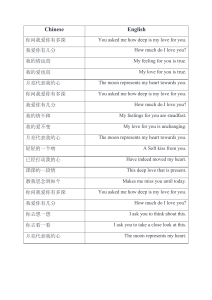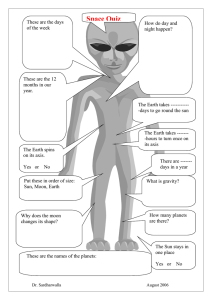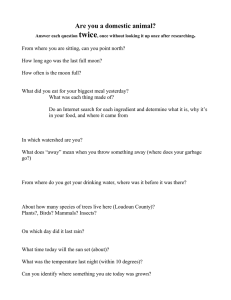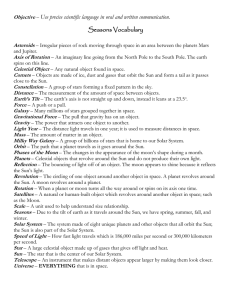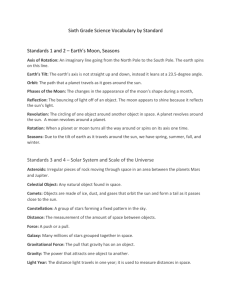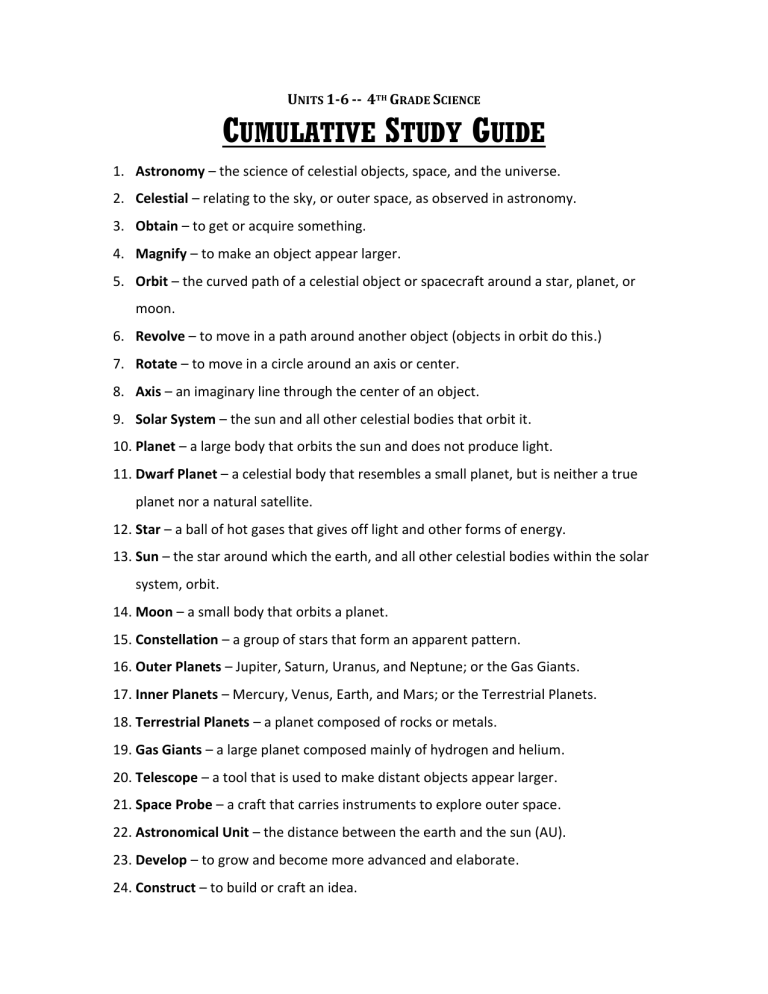
UNITS 1-6 -- 4TH GRADE SCIENCE CUMULATIVE STUDY GUIDE 1. Astronomy – the science of celestial objects, space, and the universe. 2. Celestial – relating to the sky, or outer space, as observed in astronomy. 3. Obtain – to get or acquire something. 4. Magnify – to make an object appear larger. 5. Orbit – the curved path of a celestial object or spacecraft around a star, planet, or moon. 6. Revolve – to move in a path around another object (objects in orbit do this.) 7. Rotate – to move in a circle around an axis or center. 8. Axis – an imaginary line through the center of an object. 9. Solar System – the sun and all other celestial bodies that orbit it. 10. Planet – a large body that orbits the sun and does not produce light. 11. Dwarf Planet – a celestial body that resembles a small planet, but is neither a true planet nor a natural satellite. 12. Star – a ball of hot gases that gives off light and other forms of energy. 13. Sun – the star around which the earth, and all other celestial bodies within the solar system, orbit. 14. Moon – a small body that orbits a planet. 15. Constellation – a group of stars that form an apparent pattern. 16. Outer Planets – Jupiter, Saturn, Uranus, and Neptune; or the Gas Giants. 17. Inner Planets – Mercury, Venus, Earth, and Mars; or the Terrestrial Planets. 18. Terrestrial Planets – a planet composed of rocks or metals. 19. Gas Giants – a large planet composed mainly of hydrogen and helium. 20. Telescope – a tool that is used to make distant objects appear larger. 21. Space Probe – a craft that carries instruments to explore outer space. 22. Astronomical Unit – the distance between the earth and the sun (AU). 23. Develop – to grow and become more advanced and elaborate. 24. Construct – to build or craft an idea. 25. Evaluate – to form an idea of the amount, number, or value of. 26. Seasons – the four divisions of the year, resulting from the earth’s changing position while orbiting the sun. 27. Moon Phases – when the moon presents specific reoccurring appearances. 28. New Moon – a moon phase where the moon’s nearside receives no sunlight. 29. Crescent Moon – a moon phase where the moon appears as a thin shape. 30. Gibbous Moon – a moon phase where the moon’s nearside is almost completely illuminated. 31. Quarter Moon – a moon phase where half of the moon is illuminated. 32. Full Moon – a moon phase where the moon’s nearside is completely illuminated. 33. Waxing – to grow in size, or illumination. 34. Waning – to decrease in size, or illumination. 35. Equator – an imaginary line drawn around the earth equally between the north and south poles, dividing earth into northern and southern hemispheres. 36. Hemisphere – half of a celestial sphere. 37. Weather – the state of the atmosphere at a place and time. 38. Weather – the state of the atmosphere at a place and time. 39. Climate – the usual weather conditions of a region occurring throughout the year. 40. Meteorologist – a scientist specializing in the study of weather and climate. 41. Forecast – to predict or calculate in advance what type of weather is coming. 42. Prediction – a reasoning statement made about the future. 43. Temperature – a measure of heat or cold. 44. Water Cycle – earth’s water constantly changing from one state of matter to another. 45. Evaporation – when energy from the sun causes liquid water to change into water vapor. 46. Condensation – when water vapor in the atmosphere is changed back into liquid water. 47. Precipitation – water droplets that fall from the sky. 48. Ice – water in its solid state. 49. Water – water in its liquid state. 50. Water Vapor – water in its gaseous state. 51. Thermometer – an instrument for measuring temperature. 52. Rain Gauge – an instrument for collecting and measuring the amount of rainfall. 53. Barometer – an instrument for measuring air pressure. 54. Wind Vane – an instrument for measuring the direction of wind. 55. Anemometer – an instrument for measuring the speed of wind. 56. Cirrus Clouds – clouds that form high in the sky and appear as narrow feathery bands. 57. Stratus Clouds – clouds that form low in the sky and appear as flat sheets. 58. Cumulus Clouds – large clouds that appear puffy and cotton-like. 59. Ecosystem – a biological community of interacting organisms and their physical environment. 60. Organic Matter – composed of the remains of plants, animals, and their waste. 61. Environment – the surroundings or conditions that a person, animal, or plant lives or operates. 62. Producer – organism that uses the sun’s energy to make its own food. 63. Consumer – organism that eats other living things to get energy. 64. Pollinator – an animal that causes plants to make fruit or seeds by moving pollen from one part of a flower to another. 65. Habitat – the natural home or environment of an animal, plant, or other organism. 66. Adaptation – a feature that helps a living thing survive in its environment. 67. Niche – the role and position a species has in its environment. 68. Camouflage – an adaptation that allows a living thing to blend into its surroundings. 69. Mimicry – an adaptation in which one kind of organism looks like another kind. 70. Hibernate – when animals go into a state that is like a deep sleep during cold winter months. 71. Migrate – when animals move to another place to meet their basic needs. 72. Decomposer – organisms that break down dead or decaying organisms. 73. Microorganism – an organism that can be seen only with the aid of a microscope. 74. Food Chain – a diagram that shows how food energy moves from one organism to another in a given environment. 75. Food Web – a model that shows interconnecting food chains within an ecosystem. 76. Decay – to decompose or rot. 77. Species – a group of the same kind of organism that reproduces in nature and produces offspring. 78. Era – a period of time marked by distinctive events. 79. Extinct – the complete loss of one kind of living thing. 80. Paleontologist – a scientist who studies fossils and other types of evidence to learn about life in the past. 81. Fossil – the preserved remains of a prehistoric organism. 82. Community – all the living things in an environment. 83. Population – the number of organisms of the same species that live in a particular geographic area at the same time. 84. Reproduction – to make more of its own kind. 85. Seed Dispersal – when the seeds of a plant are carried to a new place. 86. Temperate Zone – the area or region between the Tropic of Cancer and the Arctic Circle, or between the Tropic of Capricorn and the Antarctic Circle. 87. Photosynthesis – when plants use the energy of sunlight to make food. 88. Herbivore – an animal that eats plants to survive. 89. Carnivore – an animal that eats other animals to survive. 90. Omnivore – an animal that eats plants and other animals to survive. 91. Predator – an animal that hunts other animals for food. 92. Prey – an animal that is hunted for food. 93. Scavenger – an animal that feeds on dead organisms. 94. Light – energy that you can see. 95. Sound – energy that you can hear. 96. Energy – the ability to do work or cause a change. 97. Lens – a piece of glass or other transparent substance for concentrating or dispersing light rays. 98. Prism – a transparent solid body, often having triangular bases, used for dispersing light into a spectrum or for reflecting rays of light. 99. Absorb – to take in or soak up. 100. Reflect – the bouncing of light from an object’s surface. 101. Refract – the bending of light as it passes from one object to another. 102. Shadow – a dark area where light from a light source is blocked by an opaque object. 103. Opaque – impenetrable to light. 104. Translucent – when light can pass through, but objects on the other side cannot be seen clearly. 105. Transparent – when light can pass through, and objects on the other side can be seen clearly. 106. Amplitude – the distance that a wave dips down or rises higher than its center point. 107. Frequency – how often an event repeats itself over a set amount of time. 108. Medium – a substance that makes possible the transfer of energy from one location to another, especially through waves. 109. Pitch – how high or low a sound is. 110. Vibrate – a rapid, back-and-forth movement. 111. Volume – the level of loudness of a sound. 112. Wave – a vibration that travels through space and matter transferring energy from one place to another. 113. Wavelength – the distance between two peaks, or wave crests, in a wave. 114. Force – a push or a pull. 115. Motion – a change in position. 116. Mechanical Energy – stored energy of an object, plus its energy of motion. 117. Gravity – a force that pulls things toward the center of earth. 118. Friction – a force that acts when two surfaces rub together. 119. Speed – the distance an object moves in a period of time. 120. Velocity – the rate of change in an object’s position with respect to time. 121. Position – the location of an object relative to a reference point. 122. Repel – to push away. 123. Matter – anything that has mass and takes up space. 124. Mass – the amount of matter in an object. 125. Simple Machine – includes tools that make work easier by allowing pushing and pulling over increased distances. 126. Compound Machine – a machine consisting of two or more simple machines operating together. 127. Pulley – a simple machine that uses grooved wheels and a rope to raise, lower, or move a load. 128. Wheel and Axle – a simple machine that uses a round circle with a rod attached in the middle to help it lift or move loads. 129. Inclined Plane – a slanting surface connecting a lower level to a higher level. 130. Wedge – an object with at least one slanting side ending in a sharp edge, which cuts materials apart. 131. Screw – an inclined plane wrapped around a cylinder which holds things together or lifts materials. 132. Lever – a long, sturdy body that rests on a support and is used to move a heavy load with one end when pressure is applied to the other. 133. Magnet – an object that is able to pull some metals toward it. 134. Magnetic Field – the area around a magnet where there is a pulling force.

